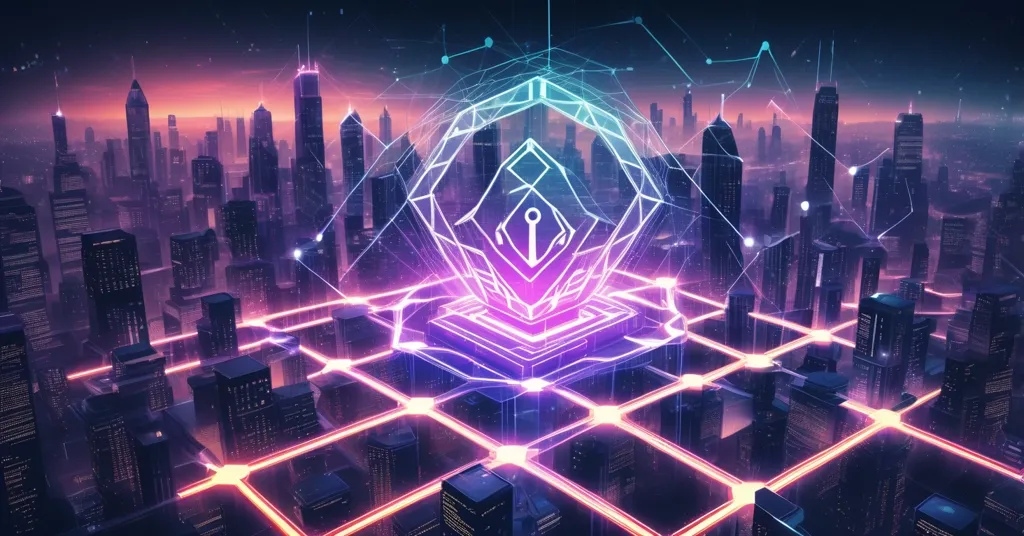Chainlink Achieves ISO 27001 and SOC 2 Compliance, Redefining DeFi Trust and Security Standards

Chainlink’s Unprecedented Feat: ISO 27001 and SOC 2 Compliance Redefine DeFi Trust
Chainlink (LINK), the titan of decentralized oracles, has just pulled off a historic coup by becoming the first oracle platform to secure both ISO 27001 and SOC 2 Type 1 compliance. This isn’t just a pat on the back—it’s a seismic shift in establishing credibility and security for decentralized finance (DeFi) at a time when hacks and data breaches are bleeding the space dry.
- Groundbreaking Standards: Chainlink secures ISO 27001 and SOC 2 certifications, a first for oracles in crypto.
- Market Grip: Holds 68% of DeFi’s total value secured (TVS), surpassing $93 billion in assets.
- Perfect Timing: Aligns with a pro-crypto U.S. regulatory wave, fueling institutional adoption.
What These Certifications Mean for Chainlink and DeFi
For those dipping their toes into crypto, let’s unpack this. Chainlink operates as a decentralized oracle network, acting as the crucial bridge that feeds real-world data into blockchain smart contracts. Imagine a DeFi lending platform needing live price data to execute a loan, or a crop insurance contract requiring weather stats to trigger payouts—Chainlink ensures that data is accurate and untamperable. Its core services, including Data Feeds (think Price Feeds for market values and Proof of Reserve for asset backing transparency) and the Cross-Chain Interoperability Protocol (CCIP, a system enabling seamless data and asset transfers across different blockchains), are now validated by these certifications. ISO 27001 is a globally recognized standard for information security management systems, ensuring robust protection against breaches. SOC 2 Type 1 focuses on operational controls around data privacy and handling, critical for user trust. In a landscape where DeFi losses from hacks have tallied into the billions, this is a hell of a big deal.
These certifications aren’t just shiny trophies; they’re a practical shield. They signal to users—retail and institutional alike—that Chainlink has rigorous processes to safeguard data integrity and prevent exploits. For instance, compliance reduces risks tied to node operators (the entities running Chainlink’s data-fetching infrastructure) by enforcing strict security protocols. It also boosts transparency for audits, a must-have for big players like banks eyeing blockchain integration. If you’re curious about what ISO 27001 and SOC 2 mean for trust in DeFi, it’s a game-changer. In short, Chainlink is setting a benchmark that could force the rest of DeFi to level up or get left behind.
Chainlink’s Crushing Market Supremacy
Chainlink isn’t just flexing with credentials; its numbers are downright intimidating. It commands a staggering 68% share of the total value secured (TVS—a metric showing the dollar value of assets protected by an oracle network) in DeFi, amounting to over $93 billion as of mid-2025. That’s 35 times more than its nearest competitor, a gap that screams why it’s the go-to for secure data. We’re talking about over 18 billion data points delivered on-chain and a mind-boggling $24 trillion in transaction value enabled. This isn’t some speculative altcoin gamble; Chainlink is the backbone of decentralized applications (dApps) across more than 60 blockchains, including Ethereum, Polygon, Solana, Avalanche, and Arbitrum. Its blockchain-agnostic design—meaning it’s not tied to any single ecosystem—gives it a versatility that many projects can only dream of.
Why does this matter? Because DeFi lives or dies on trust in data. Every lending protocol, decentralized exchange, or stablecoin peg relies on accurate inputs, and Chainlink’s dominance means it’s securing the lion’s share of that ecosystem. With a six-year track record of no major failures—holding steady through chaos like the 2020 COVID market crash and the 2022 FTX implosion—it’s proven itself under pressure. These certifications only cement that reliability, and the impact of such certifications on DeFi adoption is undeniable, making Chainlink the de facto standard for anyone serious about building or investing in DeFi.
Regulatory Tailwinds and Institutional Buy-In
The timing of this milestone couldn’t be sharper. Chainlink’s compliance lands smack in the middle of a pro-crypto regulatory push in the U.S. under President Donald Trump’s administration. Recent legislative moves like the GENIUS Act and CLARITY Act aim to foster blockchain innovation and clarify rules around digital assets, creating fertile ground for projects like Chainlink to thrive. While some of these bills are still in early stages and could hit roadblocks, the broader vibe—affirming self-custody rights and recognizing stablecoins as key infrastructure—screams opportunity. For deeper insights into the U.S. crypto regulatory changes under Trump, the landscape looks promising yet uncertain. For a platform laser-focused on security and interoperability, this couldn’t be a better backdrop to attract institutional eyes.
Speaking of institutions, Chainlink’s Rolodex reads like a Wall Street power list. Heavyweights like Swift (the global financial messaging network), UBS, J.P. Morgan, Mastercard, and Fidelity are all partnering up, publicly leaning on Chainlink to fuse traditional finance with blockchain tech. As market analysis firm Birb Nest has noted:
Chainlink is the essential link between traditional finance and blockchain economies, offering a suite of services no other project in the crypto market can match.
Community voices back this up. Zach Rynes, better known as ChainLinkGod, recently tweeted about Chainlink’s “unstoppable dominance” in collaborating with financial giants on asset tokenization. For a closer look at these partnerships with Swift and J.P. Morgan among others, the scale of integration is staggering. When Wall Street starts cozying up to a crypto protocol, you know the game’s shifting.
Real-World Asset Tokenization: Chainlink’s Next Frontier
Beyond DeFi, Chainlink is carving a niche in tokenizing real-world assets (RWAs)—think real estate, bonds, or even art turned into digital tokens on a blockchain. Its secure data feeds and CCIP make it a linchpin for this trend, bridging the old financial guard with blockchain’s transparency and efficiency. A tangible example? Chainlink’s Proof of Reserve tech underpins Bancolombia’s Colombian peso stablecoin, ensuring the asset’s backing is verifiable on-chain. This isn’t sci-fi; it’s happening now, and with certifications bolstering trust, we could see an explosion of tokenized assets as banks and governments dip their toes into blockchain waters.
This focus on RWAs ties into a broader vision of digitizing global finance. Chainlink’s ability to deliver verified data—whether it’s market prices or reserve audits—positions it as a cornerstone for integrating legacy systems with decentralized tech. If you’re interested in the specifics of how ISO 27001 and SOC 2 impact DeFi security, Chainlink’s advancements are setting a new standard. It’s not hard to picture tokenized mortgages or carbon credits trading on-chain with Chainlink as the data backbone, a disruption that could shake traditional markets to their core.
Market Moves: LINK Outshines the Giants
On the price front, Chainlink’s native token, LINK, is making waves. It surged 9% over a recent weekly timeframe, trading at $25, while Bitcoin (BTC) stumbled with a 5% loss and Ethereum (ETH) took an 8% hit in the same period. Sure, LINK remains 52% below its all-time high of $52, but this uptick hints at renewed confidence, especially as institutional adoption accelerates. Digging into tokenomics, the Chainlink Reserve—a mechanism collecting LINK tokens from network revenue to fuel long-term growth—already holds over $1 million in LINK. Coupled with Payment Abstraction tech that automates converting payments into LINK, this could spark demand as usage scales. It’s a subtle but potent driver, especially if DeFi and RWA adoption keep climbing.
The Flip Side: Why Chainlink Isn’t Bulletproof
Before we crown Chainlink the unchallenged king, let’s play devil’s advocate. Yes, the certifications and partnerships paint a damn pretty picture, but shadows loom. The regulatory landscape, while promising, is a house of cards—those pro-crypto bills could stall or get gutted, leaving DeFi players like Chainlink twisting in the wind. Even with a friendly administration, global policies vary wildly, and a crackdown elsewhere could ripple through the space.
Then there’s competition. Chainlink’s 68% TVS stranglehold is impressive, but it’s not eternal. Emerging oracle solutions or alternative data protocols could chip away at that lead, especially if they undercut on fees or innovate faster. And let’s not kid ourselves: no system in crypto is hack-proof. Oracles have historically been weak links in blockchain setups—think of past DeFi exploits where manipulated data triggered millions in liquidations via flash loan attacks. Chainlink’s decentralized node network mitigates much of this, and its track record is clean, but one slip-up could dent that reputation, certifications or not. For community perspectives, check out this discussion on Chainlink’s security certifications.
Lastly, adoption risks linger. While institutional partnerships are a coup, traditional finance moves at a glacial pace. If banks drag their feet on blockchain integration, Chainlink’s growth in RWAs could underwhelm. And for all the hype around tokenomics, LINK’s price is still tethered to broader market sentiment—another crypto winter could tank it, regardless of fundamentals.
Bitcoin Maximalism Meets Effective Accelerationism
As someone who often leans Bitcoin maximalist, I’ll always see BTC as the ultimate store of value—the digital gold that underpins this revolution. But I’ve got to give credit where it’s due: Chainlink fills a niche Bitcoin isn’t built for. BTC doesn’t need to solve cross-chain data or DeFi scalability—that’s not its fight. Protocols like Chainlink, and even Ethereum to an extent, tackle those gaps, driving the broader mission of decentralization forward. This is effective accelerationism (e/acc) at its finest: pushing disruptive tech to shatter the sclerotic financial status quo, with security and credibility as the battering ram.
Chainlink isn’t just solving the “oracle problem”—it’s redefining how blockchains handshake with reality. From securing $93 billion in DeFi to enabling trillion-dollar transaction volumes, its footprint is undeniable. For a deeper dive into the significance of Chainlink achieving ISO 27001 and SOC 2 compliance, the implications are massive. As we champion freedom, privacy, and decentralized systems, Chainlink’s latest move is a middle finger to doubters who say crypto can’t match traditional standards. It’s proving we can outdo them while staying true to the ethos of upending broken systems.
Key Questions and Takeaways
- What do ISO 27001 and SOC 2 certifications mean for Chainlink and DeFi?
They validate Chainlink’s ironclad commitment to security and operational reliability, enhancing trust in DeFi by ensuring data protection meets global standards—a critical step when hacks are rampant. - How dominant is Chainlink in the oracle space, and why does it matter?
With 68% of DeFi’s total value secured—over $93 billion—Chainlink is the unrivaled leader in providing secure data, essential for the functionality and growth of decentralized apps. - Why is the U.S. regulatory shift significant for Chainlink’s trajectory?
A pro-crypto stance under Trump’s administration, with legislation like the GENIUS Act, sets the stage for Chainlink to draw institutional players seeking compliant blockchain solutions, though risks of delays remain. - What role does Chainlink play in real-world asset tokenization?
Through verified data feeds and CCIP, Chainlink powers the digitization of assets like stablecoins and real estate, merging traditional finance with blockchain’s transparency and efficiency. - Should we temper enthusiasm despite Chainlink’s achievements?
Hell yes—regulatory uncertainty, potential competitors, and the ever-present threat of exploits mean Chainlink isn’t invincible, no matter how many badges it earns.



